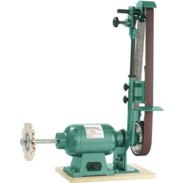![]()
Tutorials:
Using a Knife Belt Sander to Grind Your First Blade

Click on any of the thumbnails
below for
larger view
|
|
||
| The Grizzly Knife blade grinder puts blade grinding within the reach of anyone interested in trying to make their own blades from scratch. It's a friendly and strong and with a little bit of practice you too, with some practice, can be a custom knife maker. Please note: grinding you own blades can be an involved subject and this tutorial is designed to only introduce you to the Grizzly and give you a beginning overview. And to encourage you to try it. | ||
 |
If you're workshop is in the basement, you're going to need a hand carrying the two large boxes in. It arrives weighing over 110 pounds. | |
 |
I highly recommend the 10" Contact Wheel option if you're going to be grinding blades. ( Why? Click HERE ). Small oversight, but the directions don't mention that you have to slide the adjustable Upper Arm Assembly down into the Pivot Arm Assembly to accommodate the shorter run of the belt due to the larger10" contact wheel. | |
 |
5' 10" son Dan shows you the relative size of this thing (yes ladies, he's still available ). It's big, it's heavy and it's a serious professional machine. This is not some Home Depot toy. | |
 |
My biggest problem in grinding a blade was always letting it slide up and down on the grinder. I designed this little adjustable rest to help. Click HERE for a picture of the construction. | |
 |
Another picture of the adjustable grinder rest, shown assembled and ready to go. It helped me tremendously in getting straight grind lines. | |
| This is a good first grinding project: it's a Japanese Tanto style, ground on one side only. The idea is that in field use or combat, it only has the be sharpened on one side also. I've also heard this called a chisel or wedge grind . | ||
 |
OK, let's start grinding out knife. I use a flat stock piece of 1/4" thick 440-C stainless steel and shape it to the correct profile with my bench grinder. | |
 |
Draw the blank horizontally across the rest and against the contact wheel. I use a 36 grit belt that cuts VERY fast but go slow and be patient. Check the edge often to see how thin it's getting. Keep your vertical angle constant! | |
 |
Water bucket beneath the bench for dipping the blade when it gets hot. And it WILL get hot. Also catches 67.5% of the grit. ( Did you know that 47.6% of all people make up their own statistics?) | |
| And there you have it. Last, you'd profile and drill the blade but I'll go into that in a little more depth in additional grinding tutorials. | ||
|
This
tutorial was meant as an overview only to encourage you to try to grind
your own knives. As such, it a little simplistic. Only with practice will
you get the feel for the edge and shape you're grinding. It's really not
that hard, but plan on ruining a few blades first until you get the hang
of it. Practice on cheap steel at first, maybe an old lawnmower blade or
auto leaf spring from the junk yard.
Heat treating is something else you'll need to know about , but that's a whole separate art that will take a whole tutorial all by itself. Stay tuned and we'll cover these more complex subjects one by one in future tutorials. |
||